
The Hierophant – The Tarot: Major Arcana
In our next post, we’re going to go over the history of the Hierophant, the tarot’s embodiment of religious authority figures.
The earliest depictions of the Hierophant refer to him as the “Pope”. There is a reason for the name change which we will get into later. The oldest surviving tarot deck, the Visconti-Sforza, took its inspiration for the appearance of its characters from real life figures living during that time. In the case of the Pope, the person cast in the role was Pope Felix V, the last of what were referred to as the antipopes. Antipopes were individuals who attempted to oppose the power of the legitimately elected pope. In this image we see Felix seated on a throne wrapped in an ornate cape, along with early portrayals of what have now become iconic Hierophant tropes: the three-tiered crown, the staff topped by a cross, and the left hand making a blessing.
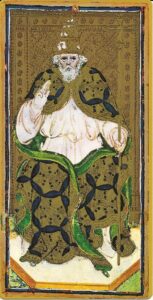
(Pictured: Visconti-Sforza Tarot)
When Tarot Marseille-style decks became more prominent, they standardized a depiction of a bearded pope seated on a throne, looking off to the right. Some artists have re-interpreted the throne as being a pair of pillars. Additionally he is wearing the triple-tiered crown and holding a triple crossed staff and we also see the introduction of two disciples who are looking up to him in the bottom of the image, one on either side of the Pope.
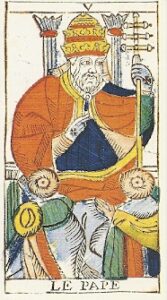
(Pictured: Claude Burdel’s Tarot Marseille)
It’s worth noting that in many areas where tarot games are played, Catholic imagery may not be desirable based on its incompatibility with the dominant spiritual beliefs of that region. There are also some Catholic communities which may see the depiction of the Pope in a tarot deck as being a sacrilege. In these cases the Pope is often replaced by a different figure denoting religious authority. German-speaking Protestant areas have historically used Jupiter, the highest-ranking German god, as their replacement. In Belgium and Northern France, Bacchus, the god of wine, was used as their substitution for the Pope. In one of the most lasting examples, the country of Bologna’s 62-card version of the tarot known as the tarrochino replaced the Empress, Emperor, the High Priestess (then known as the Papess), and the Pope with four Moorish kings referred to collectively as the Moors. Tarrochino decks published today still feature these cards.
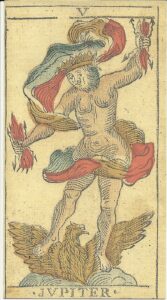
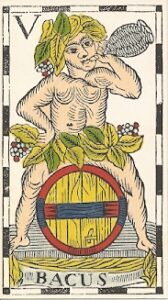
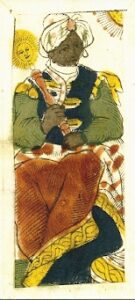
(Pictured top to bottom: German Besancon Tarot, French Vandenborre Tarot, Bologna Tarrochino)
The Oswald Wirth Tarot, which we’ve established in other articles as being one of the first tarot decks that was designed explicitly for divinatory use, took very few liberties with its depiction of the card, opting to appropriate the details from the Marseille depiction wholesale while ascribing new meaning to said symbols based on the writings of occultist Eliphas Levi. The pillared throne takes on new significance as the pillars of Hermes and Solomon, with their green coloration representing the practice of a “living” tradition. The triple cross became a lingam piercing through the three levels of reality. The two disciples became representations of the two different ways one could receive spiritual knowledge – theology and piety – and this is where Wirth makes the stylistic choice to portray them wearing opposing colors to emphasize this contrast. The Pope also became associated with the Hebrew letter He or “the breath that animates life”. Although the card itself displays the moniker “La Pape” (The Pope), Levi renamed the card “The Hierophant”, a Greek word translating to “one who shows that which is holy” to remove any explicit references to Christianity. This is how the title first emerged and eventually became more widespread as subsequent decks were released with esoteric symbolism in mind.
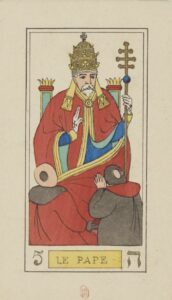
(Pictured: Oswald Wirth Tarot)
Now let’s talk about the most well known Hierophant – the one depicted in the Rider-Waite deck. Much of the imagery in this version has already been introduced in previous decks, including the three-tiered crown, the triple cross, and the two disciples. The two stone columns he is seated between have historically been built into his throne, but here they each stand independently, incorporating the fixed earth energy of Taurus, the card’s astrological correspondence. They are both grey, unlike the black and white pillars shown in the High Priestess, which in that card symbolized the balance between light and darkness. The monochromatic coloring in this card implies that the Hierophant’s version of spiritual knowledge places more emphasis on broad strokes and accessibility as opposed to nuance and mystery. This may also be why we see him clean shaven as opposed to having a beard like in older depictions. We see allusions to the Magician with the disciples wearing robes embroidered with lilies and roses which are prominent in that card’s imagery. The Hebrew letter for “nail” is seen above his crown, representing the role he plays as the link between man and spirit. There are also two interlocking keys depicted at his feet, the keys of Heaven, which symbolize the Hierophant being a spiritual gatekeeper. And finally, in case the name change obscured any suggestion that this character is based on the pope, we see crosses depicted on his robe, calling back to the card’s Catholic origins.

(Pictured: Rider-Waite Tarot)
So now that we know the history of the card’s imagery, let’s talk a bit about what it represents. As we’ve said before, the Hierophant is the tarot’s embodiment of religious authority, which in itself is quite different from spiritual authority. Spiritual authority is the authority that we are all granted by the divine. We are all given the freedom to make our own choices and experience the natural consequences of those choices. Religious authority does not come directly from the divine but from the religion itself, which sets rules in place based on its own interpretation of what spirit expects of us. You might ask “Why trust another person’s interpretation of god as opposed to my own?”. Why buy a loaf of bread from a bakery when you could make your own? Because in many situations we have to make the choice between convenience and hard work. Spirituality can be a confusing thing to understand, and the Hierophant’s role is to act as the idealized figure we model ourselves off of in order to connect to God the right way. He has devoted his life to God and established what appears to be a fulfilling relationship, so we believe that if we follow his guidance, the more connected we’ll be to God. Of course this isn’t always the case. There is no one-size-fits-all spiritual path, and religious leaders can be just as corrupt and immoral as secular ones. This is also one of the lessons of the card – while comparisons can often be inspiring and motivating, they can also lead us to have unfair expectations of ourselves and others. Ultimately one’s relationship with God is their own, and they alone determine whether or not it’s working for them. Still, the Hierophant can offer one example of how such a relationship can take shape and what kind of influence spiritual beliefs can have on a community.
So now that we know this, how would we interpret the Hierophant in the context of a tarot reading? Let’s take one example – say you’re asking a question about how to spend your money that month and you pull the Hierophant. This could be a signal to look at who your financial role models are. It may be helpful to introduce some of their habits into your own day-to-day life to achieve a positive outcome. Another example could be pulling the card in the context of a reading about love. Say you’re asking a question about how to impress your significant other’s family. The Hierophant would suggest that formalities and tradition are very important to them. Talking to your significant other about their family’s expected etiquette prior to meeting them could help prepare you to make a good first impression.
In the time since the original publication of the Visconti-Sforza, we have hundreds if not thousands of different versions of the Hierophant available to us. Many of them have done away with the standard tropes to depict the archetype through a more modern lens.
In the Muse Tarot by Chris Ann, the Hierophant has been transformed from a pope seated in a church to a statue of a feminine figure perched on a rock, gazing out at the ocean. The disciples have been replaced by two tiny travelers who have made their way to the end of a candle-lit path looking up at the statue from below. Each of the candles is an offering made by someone who has come before, and these two will each light their own as a tribute. This version of the Hierophant has no explicit Christian references and instead chooses to depict a more universal image of individuals seeking out spiritual wisdom from a traditionally honored source. I find it interesting that the source itself is not a human figure, but an inanimate object that has been sculpted by other humans and cannot change its pose. This may be symbolizing the power that the Hierophant derives from our faith in him, as well as the dogmatic nature of religion itself. This version of the card is much more accessible to a variety of traditions in terms of its imagery than traditional ones, which is fitting in that the Hierophant speaks to the limiting nature of abiding by long held conventions.
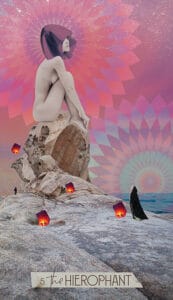
(Pictured: The Muse Tarot by Chris-Ann)
In the Tarot of Mystical Moments by Catrin Welz-Stein, the Hierophant takes the form of an owl reading a book to a young child perched on a tree branch. Owls are classic examples of traditional wisdom, and their inclusion in this version of the card evoke the energy of a loving grandfather, or a cherished older teacher, as opposed to the strict and uncompromising pope. Trees are also well known symbols of ancestral lines and the connection between earth and spirit, key aspects of the Hierophant archetype. Soon this child will be able to read books on her own and can pass that knowledge on to her own children. However, like every Hierophant, the owl cannot teach her everything. No amount of instruction will grant her the ability to fly the same way the owl does. She will have to come up with her own unique approach. Still, every single creature on this planet has something to teach us, including the owl, and if we are open to receiving like the child is, we can learn how to transcend many of our perceived limitations.
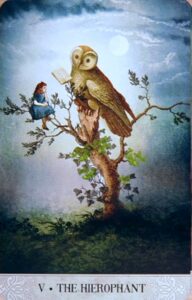
(Pictured: Tarot of Mystical Moments by Catrin Welz-Stein)
Let’s look at one last example. In the Spiritsong Tarot by Paulina Cassidy, the Hierophant has been renamed the Shaman. Shamans are individuals who interact with the spirit world while in an induced state, acting as a guide for energies to travel back and forth between the physical and spiritual world. This makes them perfect for embodying the qualities of religious authority we typically ascribe to the Hierophant. In the universe of the Spiritsong Tarot, humans have been replaced by animals, and the shaman in this card appears to be an Eagle. This is appropriate given that they are high up on the food chain and spend much of their time flying through the heavens. It also emphasizes the raw power that the Hierophant has. It can be easy to dismiss the Hierophant as being stationary and unthreatening given his dogmatism and old age, but it’s what he represents that makes him truly powerful. The Hierophant relies on the trust of his followers, but he also relies on fear. If you cross him, he could excommunicate you from the church, alienate you from your friends and family, and sentence you to an eternity in Hell. If you cross the Eagle, the fate is even worse – you’re going to get pierced by the talons and served up as dinner. This version of the card reminds us that blindly following religious authority puts us at its mercy.
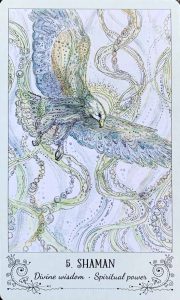
(Pictured: The Spiritsong Tarot by Paulina Cassidy)
The Hierophant is an archetype that we will all run into at some point in our lives. We all have role models that inspire us to grow and expand into better versions of ourselves. It is good to be inspired, but the key is to not put our role models on a pedestal. In the words of the late Louise Hay “Everyone is unique and different. If we are like other people, then we are not expressing our own specialness.”
The decks pictured above can all be found at our brick-and-mortar store in Northampton, MA as well as online at inspiritcrystals.com/shop!
Sources
- Tarot Heritage
- Tarot Wisdom by Rachel Pollack
- Tarot Deciphered by T. Susan Chang and M.M. Meleen